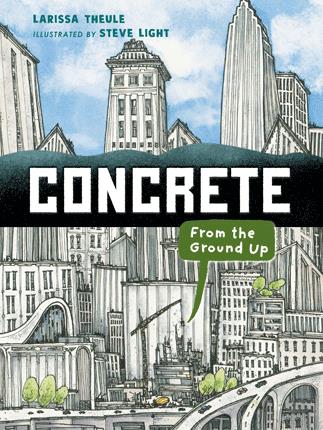| Concrete : from the ground up Author: Theule, Larissa | ||
| Price: $23.78 | ||
Summary:
From a lowly mixture of stone, sand, water, and cement have sprung sidewalks, streets, and skyscrapers, sturdy lighthouses and magnificent palaces, long bridges and massive dams. In ancient building practices, in modern engineering, and in the architecture of the future concrete plays a mighty role in the creation of the human-made world.
| Illustrator: | Light, Steve |
| Accelerated Reader Information: Interest Level: MG Reading Level: 5.20 Points: .5 Quiz: 518604 |
Reviews:
Kirkus Reviews (06/15/22)
School Library Journal (+) (10/01/22)
Booklist (+) (08/01/22)
The Hornbook (+) (00/09/22)
Full Text Reviews:
Booklist - 08/01/2022 *Starred Review* This beautifully illustrated picture book takes a rather mundane topic and turns it into something mysterious, ancient, and unlimited. Accessible introductory text with built-in definitions of new vocabulary words explains what concrete is and how it’s different from cement. A history of the substance begins with concrete’s earliest recorded use, in Turkey around 9,600 BCE, and goes to the Roman Empire (Roman architects reinforced their concrete with volcanic ash, making it superstrong and long-lasting). Alas, the recipe for concrete was lost after the fall of the empire, so builders went back to stone until the eighteenth century, when there was great need for material that would harden underwater, primarily for bridges and lighthouses. This led to a resurgence in concrete, especially once concrete reinforced with steel beams came along. Technical aspects are explained in simple terms deftly reinforced through the detailed illustrations done in pen-and-ink and watercolor. The drawings also feature various cartoon bystanders who provide side commentary and observations. Before the bibliography, the book ends with examples of how artists, engineers, and architects have used concrete in monumental, wild, and even whimsical ways, along with an invitation for readers to imagine future uses. This creative STEAM offering belongs in most collections. - Copyright 2022 Booklist.
School Library Journal - 10/01/2022 Gr 1–5—As unpretentious but essential as its subject, this is a marvelous book—an utterly compelling read. Theule (Kafka and the Doll) tells the story of concrete (not cement, but a composite material that uses cement), from ancient times to its rediscovery in the 18th century, and in pared-down style introduces readers to advanced vocabulary ("tensile," "compressive," "monolithic"); architectural monuments (the Pantheon, King Lalibela's Ethiopian rock churches, the Three Gorges Dam); professions (gladiator, emperor, civil engineer); social history (Göbekli Tepe, the building and demolition of the Berlin Wall); and more, with clarity, directness, and humor. Everything is conversationally explained: when "plastic" is used to mean "moldable," a brief speech balloon conveys that meaning. The spare but lively ink and watercolor illustrations are a perfect match for the text: unassuming but amusing, rich in detail and meaning. Iconic buildings in Sydney, Kobe, and Baku are depicted, as well as Nancy Halt's Sun Tunnels in Utah. Skin tones vary, even on toga-clad figures. Back matter includes a brief bibliography. VERDICT For elementary readers and up, this book will be read again and again.—Patricia Lothrop - Copyright 2022 Publishers Weekly, Library Journal and/or School Library Journal used with permission.



